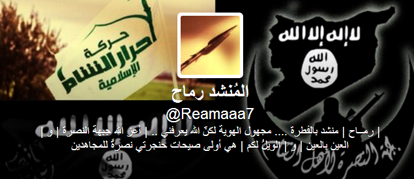NOTE: As with all guest posts, the opinions expressed below are those of the guest author and they do not necessarily represent the views of this blogs administrator and does not at all represent his employer at the Washington Institute for Near East Policy.
Jihadology.net aims to not only provide primary sources for researchers and occasional analysis of them, but also to allow other young and upcoming students as well as established academics or policy wonks to contribute original analysis on issues related to jihadism. If you would like to contribute a piece, please email your idea/post to azelin [at] jihadology [dot] net.
Click here to see an archive of all guest posts.
—
Ahrar al-Sham versus Ahrar al-Sham: The band and the militia
By Joel D. Parker
Ahrar al-Sham, a Salafi militia that emerged in late 2011, now coordinates with the Islamic Front (IF), and has attained a large and relatively well-funded forces considered to be among the single strongest militias on the side of the opposition.[1] Interestingly, Ahrar al-Sham, meaning “Free men of the Levant,” shares its name with a music group that is rooted in the popular protest movement and linked to the Free Syrian Army (FSA), and has dozens of music videos available online. While a militia and a band cannot be compared directly, the videos of Ahrar al-Sham the militia often do contain songs either in the background or as a dominant part of their message. I would like to thus compare the imagery and musical styles used by Ahrar al-Sham the band and the militia respectively, as a tool to explore possible similarities and differences within the ideologies of the dominant factions of the armed opposition.
 [2]
[2]
The band Ahrar al-Sham has recorded a number of highly-viewed anthems (anashid) since the outbreak of the uprising in March 2011, such as “Our God is God” (Ilna Allah) and “It’s not Allowed” (haram aleyh) generally sung in a cappella style out of difference to Salafi interpretations of Islamic laws.[3] However, they are decidedly not related to the militia Ahrar al-Sham, and in fact do not refer to Ahrar al-Sham the militia in their songs, rather only to the Free Syrian Army. They use the colloquial Levantine dialect declare the imminent fall of the Baʿth Party—lyrics that seem superfluous in the Islamist or Salafi context where shariʿa law tends to trump political pluralism.[4]
Ahrar al-Sham, the militia, employs a different genre of anashid, typically derived from sources predating the Syrian uprising, using only classical Arabic, and often reusing hymns recorded over the past two or three decades by singers from the Gulf States.[5] While a cappella hymns are allowed (especially to raise moral in battle), according to strict Salafi interpretations of Islamic jurisprudence, most popular singing and musical accompaniment is forbidden to the listener and musician alike.[6]
A clear division between the musical styles of the band and the militia comes to light in the differing lyrics on subjects of nationalism, territory, identity, and vision for the future. Ahrar al-Sham the band is adamant about its loyalty to Syria the country in its repeated usage of the original slogans heard on the streets in the early days of the peaceful uprising when a common motif was the slogan “Allah, Suriya, Hurriya wa Bas.” The militia does refer to Syria, but generally prefers metaphors such as “Grandsons of Umar” to refer to their broader Sunni heritage.
One of the most emotive songs of the band is “Y’allah Nihtif Sawa” (Come, let’s lift our voices together). It refers to Hama and Homs in particular, and the last verse of the song is taken from a song from the 1950s, “Skaba Ya Damuʿ al-ʿAyn” (Oh, Tears Flow).[7] The band Ahrar al-Sham’s usage of this refrain indicated the sadness of lost loved ones, and its usage became so common in the first year of the Syrian uprising that a satirical music video was made, showing Bashar singing it and crying.[8] As opposed to the pan-Islamic message of the Islamist anashid of the militia, Ahrar al-Sham the band refers only to Syria, and even appeals to “Arabs,” not Muslims in general, to join their fight against the regime of the Syrian “traitor.”
 [9]
[9]
Recently, the militia Ahrar al-Sham has begun to employ newly composed hymns in their propaganda, such as “Al-Wayl La-Kum” (A scourge on you!), which declares a curse on their enemies and a blessing on their fighters, the army of Muhammad.[10] Despite its Syrian Arabic accent (in strict literary Arabic), the Saudi-style reverb effect in the hymn alludes to Wahhabi styles of Qurʾanic recital that became popular in the 1980s.[11] The driving force of the song, which is performed by a singe who has also dedicated songs to al-Nusra Front and the Islamic State of Iraq and al-Sham, is the global jihadi momentum that appeals to individual Muslims to unite under one banner and join in the struggle against heretics, unbelievers, and “Hizb al-Lat”—a play on the Lebanese Shiʿa militia, Hezbollah, whose name means Party of God.[12]”
An overlap in the culture of both Ahrar al-Sham the band and the militia can be heard in the words of some anthems that resonate throughout the insurgency. For instance, a music video has been uploaded showing Syrian young boys singing the hymn “Allahu Akbar, ḥayya ʿala al-jihad” (God is greater, Come to Jihad!) with guns in their hands.[13] The boys call for jihad and, at the same time, use rhetoric derived from the Arab nationalist tradition that demands to know, “Where are the Arabs?” The call to jihad is a common theme today in the midst of the war against the regime, and indeed one hymn, “Jahizuna” (You Prepared Us) has been used in the videos of Ahrar al-Sham the militia as well as a number of other jihadist groups. It was recorded about a decade ago in Riyadh, Saudi Arabia, and its influence across militia groups reflects the cultural and political strength of Gulf States on the Syrian conflict.[14]
In the wider sphere that produced the anashid of both Ahrar al-Sham the militia and Ahrar al-Sham the band, certain shared themes are derived from contemporary Islamist culture and its Gulf-oriented posture. The main difference then is that the FSA-linked music group directs its message towards the Arab Sunnis of Syria fighting against Asad, while the Salafi militia of the IF targets its message towards the wider Sunni world, where many view the current struggle in broader geopolitical terms.
So Iraq and al-Sham our ours,
Grave sites of the lackeys of the Jews
Who won’t escape our sword alive
For our heroes signify the resistance
فشامنا وعراقنا
مقابر أذناب اليهود
لن يخرج حيٌ بحربنا
فأبطالنا رمز الصمود

Reblogged this on nawaemuslim.